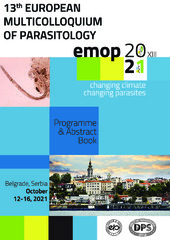Приказ основних података о документу
Combating Anthelmintic Resistance in Ruminants: A Serbian Perspective
| dc.creator | Simin, Stanislav | |
| dc.creator | Živković, Nebojša | |
| dc.creator | Pušić, Ivan | |
| dc.creator | Stojanov, Igor | |
| dc.creator | BECSKEI, Zsolt | |
| dc.creator | Lalošević, Vesna | |
| dc.creator | Vračar, Vuk | |
| dc.creator | Štrbac, Filip | |
| dc.creator | Ratajac, Radomir | |
| dc.creator | Rinaldi, Laura | |
| dc.creator | Sotiraki, Smaragda | |
| dc.creator | Charlier, Johannes | |
| dc.date.accessioned | 2023-06-05T10:58:39Z | |
| dc.date.available | 2023-06-05T10:58:39Z | |
| dc.date.issued | 2021 | |
| dc.identifier.uri | http://rimsi.imsi.bg.ac.rs/handle/123456789/1973 | |
| dc.description.abstract | Heavy reliance on anthelmintics to control gastrointestinal nematodes (GIN) of grazing ruminants, led to the emergence of anthelmintic resistance (AR), a well known global problem to sustainable animal production, health and welfare. Ruminant producers in Serbia are seldomly aware of the serious losses that GIN can cause. Although resistance of Trichostrongylus spp. to ivermectin (IVM) was detected earlier in sheep, they rarely know about the existence of AR. To address the AR issue in a new manner, several Serbian researchers attended COMBAR training schools (TSs) and short term scientific missions (STSMs) in order to acquire new skills for improved diagnostics and control of GIN, such as the application of the Mini FLOTAC technique and the conduct of faecal egg count reduction tests (FECRTs) for monitoring anthelmintic efficacy. Using Mini FLOTAC, a set of small scale surveys was performed, to monitor GIN in grazing cattle (50 animals from 5 herds) and assess anthelmintic efficacy in sheep (11 farms tested for IVM, 3 farms tested for levamisole (LEV)) and goats (one farm tested for IVM, eprinomectin (EPR) and albendazole (ALB)). Results showed low levels of GIN infection in cattle (average 13 eggs per gram (epg), range 5-95 epg). In the goat farm, resistance to EPR and IVM was detected (percentage of egg reductions= 83 and 92%, respectively), while ALB retained full efficacy. Regarding sheep, AR to IVM was established in 8 farms (73%), with egg reductions ranging from 55 to 92%, while LEV showed full efficacy against GIN. An STSM supported the evaluation of essential oils from Serbian native plants against GIN using in vitro studies and showed promising results. Overall, COST Action COMBAR is contributing to sustainable parasite control in Serbia through training researchers in new research practices. | sr |
| dc.language.iso | en | sr |
| dc.publisher | Serbian Society of Parasitology | sr |
| dc.relation | COST Action COMBAR (Combatting Anthelmintic Resistance in Ruminants), number CA16230 | sr |
| dc.rights | openAccess | sr |
| dc.source | Proceedings of 3th European Multicolloquium of Parasitology: „Changing climate changing parasites“ | sr |
| dc.subject | ruminants | sr |
| dc.subject | gastrointestinal nematodes | sr |
| dc.subject | anthelmintic resistance | sr |
| dc.subject | faecal egg count reduction test | sr |
| dc.subject | alternatives | sr |
| dc.title | Combating Anthelmintic Resistance in Ruminants: A Serbian Perspective | sr |
| dc.type | conferenceObject | sr |
| dc.rights.license | ARR | sr |
| dc.citation.epage | 55 | |
| dc.citation.spage | 55 | |
| dc.identifier.fulltext | http://rimsi.imsi.bg.ac.rs/bitstream/id/4957/bitstream_4957.pdf | |
| dc.identifier.rcub | https://hdl.handle.net/21.15107/rcub_rimsi_1973 | |
| dc.type.version | publishedVersion | sr |

